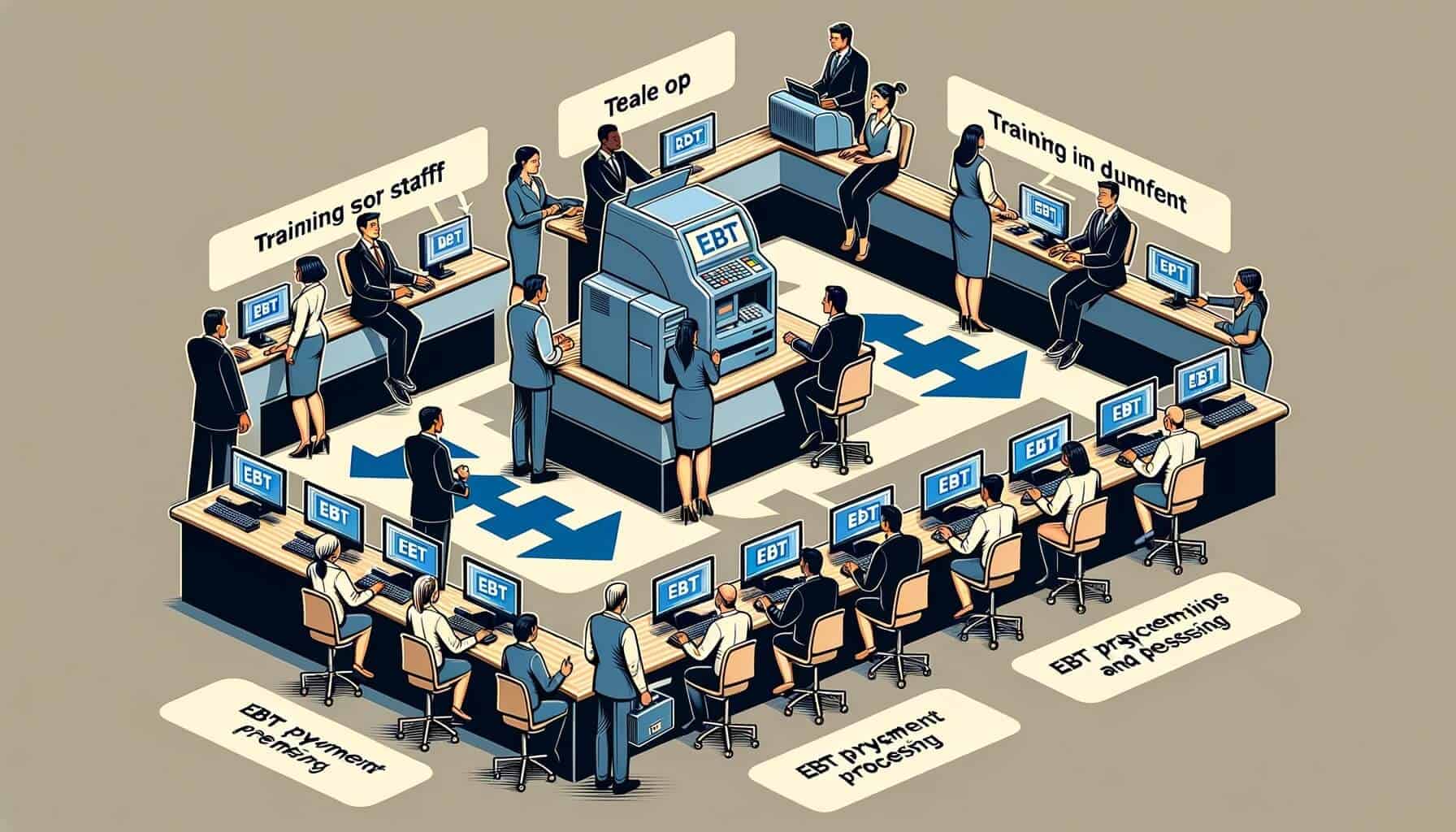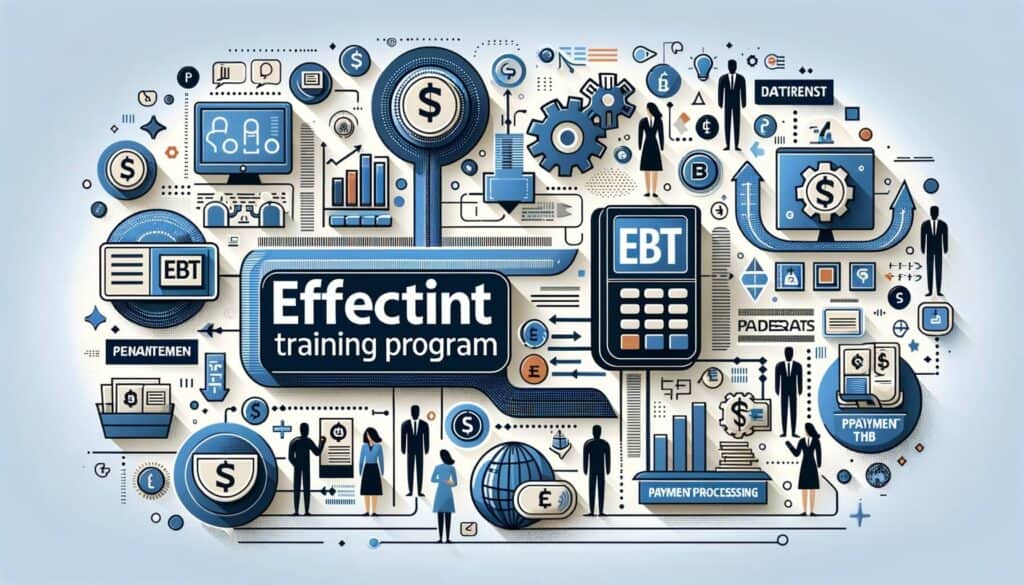
By Sharon Watson April 9, 2025
In today’s digital age, electronic benefit transfer (EBT) payment processing has become an essential part of the welfare system. EBT allows recipients to access their benefits through a card, similar to a debit or credit card, instead of receiving paper checks or vouchers. This system offers convenience, security, and efficiency for both recipients and retailers.
However, to ensure smooth and error-free transactions, it is crucial to train staff members who handle EBT payment processing. This comprehensive guide will provide insights into the basics of EBT payment systems, the importance of staff training, assessing training needs, developing effective training programs, training methods and techniques, overcoming common challenges, monitoring and evaluating staff performance, and addressing frequently asked questions.
Understanding the Basics of EBT Payment Systems

EBT payment systems are designed to provide a seamless and secure method for distributing benefits to eligible individuals and families. These benefits can include Supplemental Nutrition Assistance Program (SNAP) benefits, Temporary Assistance for Needy Families (TANF) benefits, and other state-administered programs.
EBT cards, issued by state agencies, function like debit cards and are loaded with the recipient’s allocated benefits. When making a purchase, the recipient swipes the EBT card at a point-of-sale (POS) terminal, enters a personal identification number (PIN), and the transaction is processed electronically.
Importance of Training Staff for EBT Payment Processing

Training staff members who handle EBT payment processing is crucial for several reasons. Firstly, it ensures compliance with federal and state regulations governing the use of EBT cards. Staff members need to be aware of the rules and restrictions associated with EBT transactions to prevent misuse or fraud.
Secondly, proper training helps staff members understand the technical aspects of EBT payment systems, including how to operate POS terminals, troubleshoot common issues, and handle customer inquiries. Thirdly, training enhances customer service by equipping staff members with the knowledge and skills to assist EBT cardholders effectively. Lastly, training reduces errors and improves efficiency, leading to cost savings for retailers and a better experience for EBT recipients.
Assessing Staff Training Needs for EBT Payment Processing

Before developing a training program, it is essential to assess the training needs of staff members involved in EBT payment processing. This assessment can be done through various methods, such as surveys, interviews, and observations. The goal is to identify knowledge gaps, skill deficiencies, and areas where staff members may require additional support. Some key areas to assess include:
1. Knowledge of EBT regulations and policies: Staff members should have a thorough understanding of the rules and regulations governing EBT payment processing to ensure compliance.
2. Technical proficiency: Assess the staff’s familiarity with POS terminals, software systems, and troubleshooting common issues that may arise during EBT transactions.
3. Customer service skills: Evaluate staff members’ ability to provide excellent customer service to EBT cardholders, including handling inquiries, resolving complaints, and maintaining a professional demeanor.
4. Communication skills: Assess staff members’ communication skills, both verbal and written, as clear and effective communication is crucial in EBT payment processing.
5. Problem-solving abilities: Determine staff members’ problem-solving skills, as they may encounter various challenges during EBT transactions that require quick thinking and decision-making.
Developing an Effective Training Program for EBT Payment Processing

Once the training needs have been assessed, it is time to develop an effective training program for staff members involved in EBT payment processing. A well-designed program should cover the following components:
1. Clear learning objectives: Define specific learning objectives that align with the training needs assessment. These objectives should be measurable and focused on improving staff members’ knowledge, skills, and performance in EBT payment processing.
2. Comprehensive content: Develop training materials that cover all aspects of EBT payment processing, including regulations, technical procedures, customer service, and problem-solving. Use a variety of formats, such as presentations, videos, and interactive activities, to engage learners.
3. Engaging delivery methods: Choose delivery methods that suit the needs and preferences of staff members. This can include in-person training sessions, online courses, webinars, or a combination of different approaches. Ensure that the training is interactive, allowing participants to ask questions, practice skills, and receive feedback.
4. Practical exercises and simulations: Incorporate practical exercises and simulations into the training program to provide hands-on experience. This can include role-playing scenarios, case studies, and mock EBT transactions. Practical exercises help staff members apply their knowledge and skills in a realistic setting, preparing them for real-world situations.
5. Ongoing support and resources: Provide ongoing support and resources to staff members after the initial training. This can include access to reference materials, job aids, online forums, and mentoring programs. Ongoing support ensures that staff members can continue to enhance their skills and stay updated on any changes in EBT payment processing.
Training Methods and Techniques for EBT Payment Processing
When training staff members for EBT payment processing, it is essential to use a variety of methods and techniques to cater to different learning styles and preferences. Here are some effective training methods and techniques to consider:
1. Classroom training: In-person classroom training allows for direct interaction between trainers and staff members. It provides an opportunity for participants to ask questions, engage in discussions, and receive immediate feedback. Classroom training can be supplemented with visual aids, handouts, and group activities to enhance learning.
2. Online courses: Online courses offer flexibility and convenience, allowing staff members to complete training at their own pace and from any location. Online courses can include interactive modules, quizzes, and assessments to ensure comprehension and retention of the material.
3. Webinars: Webinars are live online presentations that allow trainers to deliver content to a large audience simultaneously. Staff members can participate in webinars from their own computers or mobile devices, making it a cost-effective and accessible training method. Webinars can include interactive polls, chat features, and Q&A sessions to engage participants.
4. On-the-job training: On-the-job training involves shadowing experienced staff members or trainers while they perform EBT payment processing tasks. This hands-on approach allows new staff members to observe and learn from experienced professionals, gaining practical skills and knowledge.
5. Role-playing: Role-playing exercises involve staff members acting out different scenarios related to EBT payment processing. This technique helps develop problem-solving skills, customer service skills, and the ability to handle challenging situations. Trainers can provide feedback and guidance during the role-playing exercises to enhance learning.
Common Challenges in EBT Payment Processing and How to Overcome Them
While EBT payment processing offers numerous benefits, there are also common challenges that staff members may encounter. Being aware of these challenges and knowing how to overcome them is crucial for successful EBT payment processing. Here are some common challenges and strategies to address them:
1. Technical issues: POS terminals or software systems may experience technical glitches or connectivity problems, leading to transaction failures. To overcome this, staff members should be trained on troubleshooting techniques and have access to technical support resources.
2. Fraud prevention: EBT payment processing requires strict adherence to regulations to prevent fraud or misuse of benefits. Staff members should be trained on identifying suspicious transactions, verifying cardholder identities, and reporting any potential fraud to the appropriate authorities.
3. Customer inquiries: EBT cardholders may have questions or concerns about their benefits, transaction history, or account balance. Staff members should be trained on how to handle these inquiries professionally, providing accurate information and resolving issues promptly.
4. Language barriers: Staff members may encounter EBT cardholders who have limited English proficiency. Training should include strategies for effective communication with individuals who speak different languages, such as using translation services or multilingual staff members.
5. Time management: EBT payment processing can be time-consuming, especially during peak hours or when dealing with complex transactions. Staff members should be trained on time management techniques, prioritizing tasks, and maintaining efficiency without compromising accuracy.
Monitoring and Evaluating Staff Performance in EBT Payment Processing
Monitoring and evaluating staff performance in EBT payment processing is essential to ensure compliance, identify areas for improvement, and provide ongoing support. Here are some strategies for monitoring and evaluating staff performance:
1. Performance metrics: Establish key performance indicators (KPIs) to measure staff members’ performance in EBT payment processing. These metrics can include transaction accuracy rates, customer satisfaction scores, and adherence to regulations. Regularly track and analyze these metrics to identify trends and areas for improvement.
2. Quality assurance checks: Conduct regular quality assurance checks to assess staff members’ adherence to EBT payment processing procedures and regulations. This can involve reviewing transaction records, observing staff members in action, and providing feedback on areas that need improvement.
3. Customer feedback: Gather feedback from EBT cardholders regarding their experience with staff members. This can be done through surveys, comment cards, or online reviews. Analyze the feedback to identify any recurring issues or areas where staff members excel.
4. Ongoing training and development: Provide ongoing training and development opportunities to staff members based on their performance evaluations. This can include refresher courses, advanced training on specific topics, or mentoring programs. Ongoing training ensures that staff members continue to enhance their skills and stay updated on best practices.
Frequently Asked Questions (FAQs) about EBT Payment Processing
Q1: What is the difference between EBT and traditional payment methods?
A1: EBT payment processing replaces traditional paper checks or vouchers with electronic cards, providing a more secure and convenient method for distributing benefits to eligible individuals and families.
Q2: Can EBT cards be used for any type of purchase?
A2: EBT cards can be used to purchase eligible items, such as groceries, at authorized retailers. However, they cannot be used for non-essential items, such as alcohol or tobacco.
Q3: How can retailers become authorized to accept EBT payments?
A3: Retailers interested in accepting EBT payments need to apply for authorization through their state’s EBT program. The application process typically involves meeting certain criteria and completing the necessary paperwork.
Q4: What should retailers do if they encounter a problem with an EBT transaction?
A4: Retailers should have trained staff members who can troubleshoot common issues, such as card declines or connectivity problems. If the issue cannot be resolved, retailers should contact their EBT program provider for assistance.
Q5: How can retailers prevent fraud in EBT payment processing?
A5: Retailers should train staff members on identifying suspicious transactions, verifying cardholder identities, and following proper procedures to prevent fraud. They should also report any potential fraud to the appropriate authorities.
Conclusion
Training staff members for EBT payment processing is crucial for ensuring compliance, efficiency, and customer satisfaction. By understanding the basics of EBT payment systems, assessing training needs, developing effective training programs, using various training methods and techniques, overcoming common challenges, and monitoring staff performance, retailers can provide a seamless and secure experience for EBT cardholders.
Ongoing training and evaluation are essential to keep staff members updated on best practices and continuously improve their skills. With proper training, staff members can confidently handle EBT payment processing, contributing to the success of the welfare system and the well-being of those who rely on it.